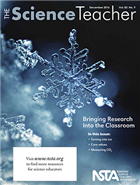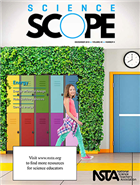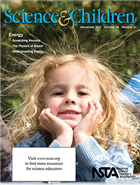Ideas and inspiration from NSTA’s December K-12 journals
By Mary Bigelow
Posted on 2016-12-18

Elementary and middle school teachers have a real gold mine this month – both journals have the theme of Energy.
Food for thought at any grade level–Commentary: Proactive Leadership in The Science Teacher describes what leadership should look like for teachers, departments, and administrators.
The Science Teacher — Bringing Research Into the Classroom
This issue goes beyond talking about research results to describe students actually doing authentic research—planning and carrying out investigations, generating and evaluating data, and developing explanations or designing solutions. The lessons described in the articles include connections with the NGSS.
- Core Values includes several lessons in which students analyze and summarize data from an expedition in Siberia. The purpose is to see how scientists can reconstruct past climate records historically without having direct measurements.
- Measuring CO2 illustrates an investigation in which students study greenhouse gas production from thawing permafrost.
- In the interdisciplinary investigation, Turning Into Ice, students explore the concepts and processes of biological ice nucleation.
- Modeling Chromosomes focuses on a 5E lesson in which students create models using strips of paper to demonstrate their understanding of genetic concepts.
- Science 2.0: Developing the Knowledge Constructor describes four indicators showing that students can synthesize information from a variety of sources and resources into a representation of their knowledge.
- Focus on Physics: How E = mc2 Helps Us Understand Nuclear Fission and Fusion describes how Einstein’s familiar equation relates to the reductions in mass and enormous releases of energy that occur in the processes of nuclear fission and fusion.
- Students may be surprised at the added sugars in foods as noted in Health Wise: Keeping Track of Sugar.
For more on the content that provides a context for these projects and strategies see the SciLinks topics Carbon Cycle, Chromosomes, Climates of the World, Fission, Fusion, Genes, Genome , Greenhouse Gases, Ice Ages, Nutrients, Respiration, Water Cycle
Keep reading for Science Scope and Science & Children
 Science Scope — Energy
Science Scope — Energy
“Energy is all around us, making this cross-cutting concept relatively easy to incorporate into your teaching,” according to the editor, and middle schoolers are full of energy (in another sense). Featured articles that describe lessons include a helpful sidebar (“At a Glance”) documenting the big idea, essential pre-knowledge, time, and cost. The lessons also include connections with the NGSS.
- Rube Goldberg machines that incorporate several types of energy are popular with students. Designing and Building a Rube Goldberg Machine to Contextualize a Unit on Energy aligns this project-based science activity with the NGSS.
- I Get It! Moving Students From Misconceptions to Conceptual Change includes a four-phase process to guide students in developing their science knowledge.
- Another design opportunity is described in Design an Energy-Efficient House: Applying Multidisciplinary Knowledge to Solve a Design Challenge which incorporates engineering and science concepts into an authentic project.
- Food and Energy for All: Turning a Demonstration Into an Inquiry Activity expands a traditional lesson into an investigation into factors that affect the rate of photosynthesis.
- Students explore the Law of Conservation of Energy, kinetic and potential energy, Newton’s Laws, and elastic potential in this Classic Lessons 2.0: The Come Back Can using readily available materials.
- Citizen Science: Power Up Science Learning With NOVA’s Energy Lab describes a free computer simulation that challenges students to uses real-world data to construct a renewable energy system for a city.
- Disequilibrium: A Human Circuit illustrates with a 5E lesson how students can create circuits without batteries.
- Teachers share their ideas and experiences in energy-related lessons in this month’s Listserv Roundup: Getting Smart With Energy.
- Teacher to Teacher: Predicting, Explaining, and Observing Thermal Energy Transfer incorporates a formative assessment probe to determine their prior knowledge.
For more on the content that provides a context for these projects and strategies see the SciLinks topics Conductors/Insulators, Elastic Forces, Electric Circuits, Heat Transfer, Insulation, Kinetic and Potential Energy, Law of Conservation of Energy, Newton’s Laws of Motion, Photosynthesis, Renewable Sources of Energy.
 Science & Children – Energy
Science & Children – Energy
“Understanding energy…is embedded in all of the science and technology disciplines and therefore revisited many times throughout students’ STEM education” and is “compelling.“
The featured articles describe compelling activities and investigations on the topic.
- Scratching Records has a 5E lesson that investigates static electricity, with probing questions and examples of student work.
- PreK students explore the characteristics of sound The Physics of Sound through a learning center and focus questions.
- The 5E lesson highlighted in Making Sense of Sound investigates the conceptions and misconceptions elementary students have about sound and construct explanations.
- Getting Crafty With the NGSS describes three projects in which students construct models of circuits using different media. The article includes photos of the student products. Read Science 101: What’s Really Going on in Electric Circuits? if you need refresher on the topic.
- The authors of Understanding Energy share their 5E lesson in which students investigate the flow of energy in everyday life,
- The Early Years: Preparing for Spring Gardening has suggestions for helping our youngest scientists explore heat and temperature as they determine the best time to plant outdoors.
- The two 5E lessons in Teaching Through Trade Books: The Sounds of Science have ideas for helping students observe the characteristics of sound and how it travels.
- The Poetry of Science: Light and Sound includes a poem and teaching suggestions on sound waves.
- Engineering Encounters: Robots, Bookmarks, and Guitars, Oh My! adds an A to STEM to incorporate the arts into a unit on electricity.
For more on the content that provides a context for these projects and strategies see the SciLinks topics Law of Conservation of Energy, Electricity, How Can Heat Be Measured?, How Is Heat Produced and Used, Interactions of Sound Waves, Photosynthesis, Properties of Sound, Sound, Static Electricity, Sun, Weather
Disclaimer: The views expressed in this blog post are those of the author(s) and do not necessarily reflect the official position of the National Science Teaching Association (NSTA).


